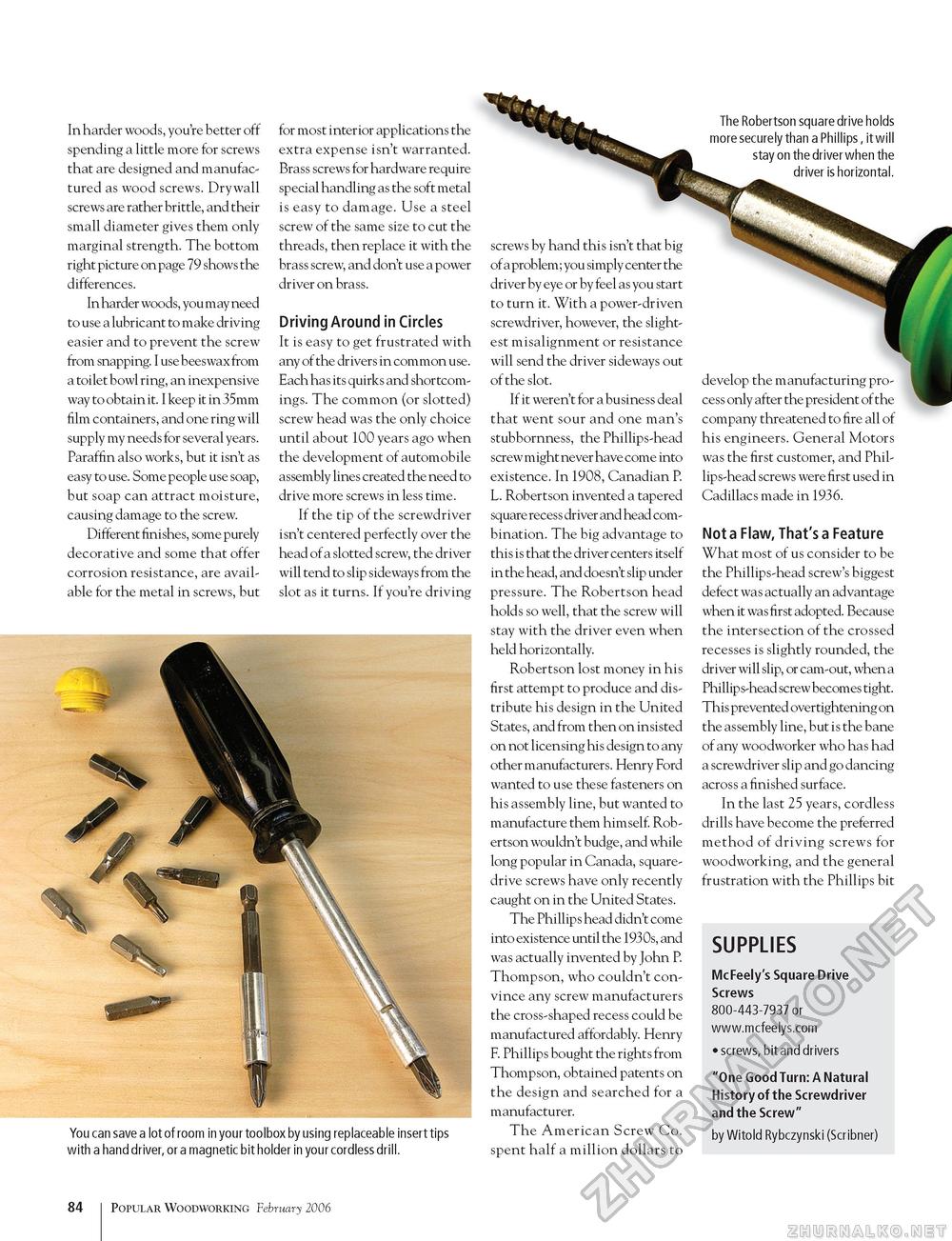Popular Woodworking 2006-02 № 153, страница 83
In harder woods, you're better off spending a little more for screws that are designed and manufactured as wood screws. Drywall screws are rather brittle, and their small diameter gives them only marginal strength. The bottom right picture on page 79 shows the differences. In harder woods, you may need to use a lubricant to make driving easier and to prevent the screw from snapping. I use beeswax from a toilet bowl ring, an inexpensive way to obtain it. I keep it in 35mm film containers, and one ring will supply my needs for several years. Paraffin also works, but it isn't as easy to use. Some people use soap, but soap can attract moisture, causing damage to the screw. Different finishes, some purely decorative and some that offer corrosion resistance, are available for the metal in screws, but for most interior applications the extra expense isn't warranted. Brass screws for hardware require special handling as the soft metal is easy to damage. Use a steel screw of the same size to cut the threads, then replace it with the brass screw, and don't use a power driver on brass. Driving Around in Circles It is easy to get frustrated with any of the drivers in common use. Each has its quirks and shortcomings. The common (or slotted) screw head was the only choice until about 100 years ago when the development of automobile assembly lines created the need to drive more screws in less time. If the tip of the screwdriver isn't centered perfectly over the head of a slotted screw, the driver will tend to slip sideways from the slot as it turns. If you're driving The Robertson square drive holds more securely than a Phillips , it will stay on the driver when the driver is horizontal. You can save a lot of room in your toolbox by using replaceable insert tips with a hand driver, or a magnetic bit holder in your cordless drill. screws by hand this isn't that big of a problem; you simply center the driver by eye or by feel as you start to turn it. With a power-driven screwdriver, however, the slightest misalignment or resistance will send the driver sideways out of the slot. If it weren't for a business deal that went sour and one man's stubbornness, the Phillips-head screw might never have come into existence. In 1908, Canadian P. L. Robertson invented a tapered square recess driver and head combination. The big advantage to this is that the driver centers itself in the head, and doesn't slip under pressure. The Robertson head holds so well, that the screw will stay with the driver even when held horizontally. Robertson lost money in his first attempt to produce and distribute his design in the United States, and from then on insisted on not licensing his design to any other manufacturers. Henry Ford wanted to use these fasteners on his assembly line, but wanted to manufacture them himself. Robertson wouldn't budge, and while long popular in Canada, square-drive screws have only recently caught on in the United States. The Phillips head didn't come into existence until the 1930s, and was actually invented by John P. Thompson, who couldn't convince any screw manufacturers the cross-shaped recess could be manufactured affordably. Henry F. Phillips bought the rights from Thompson, obtained patents on the design and searched for a manufacturer. The American Screw Co. spent half a million dollars to develop the manufacturing process only after the president of the company threatened to fire all of his engineers. General Motors was the first customer, and Phillips-head screws were first used in Cadillacs made in 1936. Not a Flaw, That's a Feature What most of us consider to be the Phillips-head screw's biggest defect was actually an advantage when it was first adopted. Because the intersection of the crossed recesses is slightly rounded, the driver will slip, or cam-out, when a Phillip s-head screw becomes tight. This prevented overtightening on the assembly line, but is the bane of any woodworker who has had a screwdriver slip and go dancing across a finished surface. In the last 25 years, cordless drills have become the preferred method of driving screws for woodworking, and the general frustration with the Phillips bit SUPPLIES McFeely's Square Drive Screws 800-443-7937 or www.mcfeelys.com • screws, bit and drivers "One Good Turn: A Natural History of the Screwdriver and the Screw" by Witold Rybczynski (Scribner) 84 102 Popular Woodworking February 2006 |








